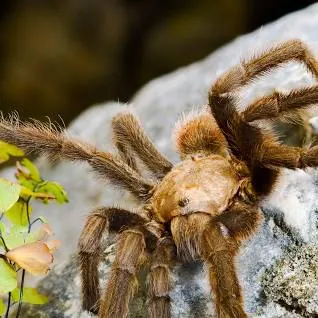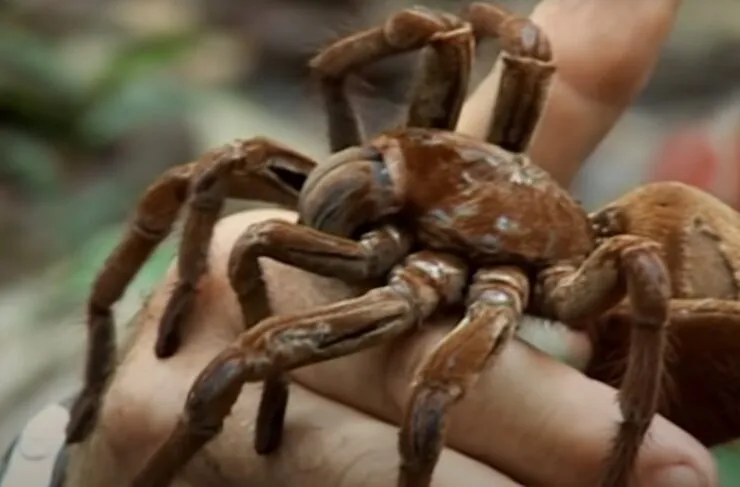What is a Texas Tarantula
The Texas tarantula, scientifically known as Aphonopelma hentzi, is a large, hairy spider native to the southwestern United States, particularly Texas. These fascinating creatures are a part of the Theraphosidae family and are renowned for their impressive size and relatively docile nature. They are often encountered by outdoor enthusiasts and are a significant part of the local ecosystem. These spiders play a crucial role in controlling insect populations, making them a beneficial presence in their natural habitats. Their existence also adds to the biodiversity of the region, making the study and understanding of the Texas tarantula important.
Physical Characteristics
Size and Appearance

Texas tarantulas are easily recognizable due to their large size. Females can have a leg span of up to 5-6 inches, while males are typically smaller. Their bodies are covered in short, dense hairs, which give them a fuzzy appearance. This hairy covering serves several purposes, including sensory perception and protection. The sheer size of these spiders often surprises those who encounter them for the first time, adding to their mystique. Their robust build is an adaptation to their terrestrial lifestyle and helps them navigate their environment efficiently. Their impressive size is a factor that contributes to their dominance in the local invertebrate food web.
Coloration and Markings
The coloration of Texas tarantulas varies, but they typically display shades of brown, tan, and black. This coloration provides excellent camouflage, helping them blend in with their surroundings. The specific markings can differ between individuals, but they often have patterns on their carapace (the upper shell) and legs. The overall appearance helps the tarantula to remain hidden from both predators and prey. The subtle variations in color and markings allow for individual identification within the population. These subtle variations are what make each tarantula unique.
Habitat and Distribution
Geographic Range

Texas tarantulas are primarily found in the southwestern United States. They are most prevalent in Texas, as their name suggests, but also inhabit parts of Oklahoma, Arkansas, and Louisiana. Their distribution is heavily influenced by the availability of suitable habitats and the presence of their preferred prey. Understanding their geographical range is essential for conservation efforts and for anyone hoping to encounter these spiders in the wild. The warm, arid climate of their habitat provides the ideal conditions for their survival and reproduction. Observing these spiders in their natural habitat is a unique experience.
Preferred Habitats
These spiders prefer dry, open habitats, including grasslands, scrublands, and woodlands. They are commonly found in burrows, which they dig themselves or occupy abandoned rodent holes. The burrows provide protection from the elements and predators, and also serve as a safe space for molting and mating. The availability of suitable soil for burrowing is a crucial factor in determining where these spiders can thrive. They often select locations near rocks or other features that help maintain the structural integrity of their burrows.
Diet and Feeding Habits
Prey and Hunting Techniques

Texas tarantulas are primarily nocturnal hunters. Their diet consists mainly of insects, such as crickets, grasshoppers, and beetles. They also occasionally prey on small vertebrates like lizards and mice. They use their keen sense of vibration to detect prey and ambush them, injecting venom to subdue their victims. The hunting techniques of the Texas tarantula showcase their adaptability and efficiency as predators. Their diet is a crucial factor in maintaining the balance of their ecosystem and reducing pest populations.
Feeding Frequency
The feeding frequency of Texas tarantulas varies depending on their age, size, and the availability of food. Adult tarantulas can survive for several months without eating, while younger spiders require more frequent meals. They typically eat a few times per month, but this can vary. Their ability to survive for extended periods without food is an adaptation to the unpredictable nature of their environment. When they do feed, they can consume a significant amount of food, storing nutrients for future needs.
Behavior and Lifestyle
Activity Patterns

Texas tarantulas are primarily nocturnal, meaning they are most active at night. During the day, they remain in their burrows, conserving energy and avoiding the heat. At night, they emerge to hunt and search for mates. This nocturnal behavior helps them avoid predators and reduces competition with diurnal species. The activity patterns of these spiders are closely tied to environmental conditions and the availability of prey.
Defensive Mechanisms
When threatened, Texas tarantulas have several defensive mechanisms. They can flick urticating hairs from their abdomen, which irritate the skin and eyes of potential predators. They also have large fangs and can bite if they feel cornered, although their venom is not considered particularly dangerous to humans. They are generally docile spiders, but they will defend themselves if necessary. The defensive mechanisms are critical for the survival of the tarantula in its natural environment.
Reproduction and Life Cycle
Mating Rituals

Mating in Texas tarantulas typically occurs in the late summer and early fall. Male tarantulas embark on a search for females, often traveling long distances. They drum on the ground to attract females, and if a female is receptive, they will engage in a mating ritual. This ritual involves careful maneuvering to avoid being mistaken for prey. The mating process is a delicate balance of attraction and caution, ensuring the survival of both partners.
Egg Sac and Spiderlings
After mating, the female produces an egg sac, which she carefully guards in her burrow. The egg sac contains hundreds of eggs, which hatch into spiderlings. The spiderlings remain with their mother for a short period before dispersing to establish their own burrows. The care provided by the mother is crucial for the survival of the young spiderlings. The journey from egg to adult is a complex process involving several molts.
Conservation Status and Threats
Threats to the Texas Tarantula

The Texas tarantula faces several threats, including habitat loss due to urbanization and agriculture, and the use of pesticides. They are also sometimes collected for the pet trade, which can impact wild populations. Climate change also poses a threat, as changes in temperature and rainfall patterns can affect their habitat and prey availability. These threats highlight the importance of conservation efforts to protect the Texas tarantula.
Conservation Efforts
Several conservation efforts are in place to protect Texas tarantulas. These include habitat preservation, public education, and regulations on the pet trade. Research into their biology and ecology is also ongoing, which helps inform conservation strategies. Protecting their natural habitats is essential for ensuring the long-term survival of the Texas tarantula. Supporting these efforts helps protect these fascinating creatures.
In conclusion, the Texas tarantula is a remarkable species with a fascinating biology and lifestyle. Understanding these amazing facts about the Texas tarantula helps us appreciate the importance of their role in the ecosystem and the need for ongoing conservation efforts. By protecting their habitat and mitigating threats, we can ensure that future generations can continue to marvel at these incredible creatures. Their presence enriches the biodiversity of the southwestern United States.
